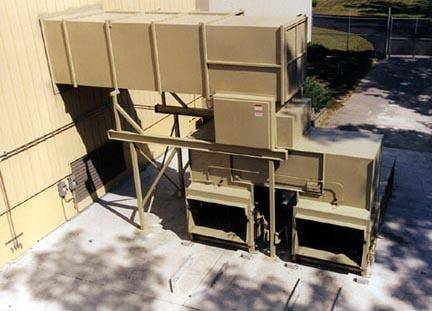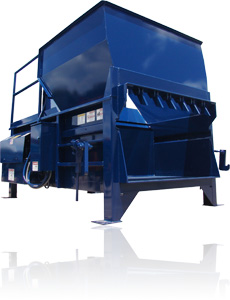Exploring the top features of Commercial trash compactor equipment
Wiki Article
Comprehending the Different Uses Waste Tools in the Recycling Sector
The reusing market depends heavily on specialized waste devices to optimize processing and recovery. Each tool, from shredders to balers, offers a distinctive objective that enhances total performance. Recognizing these duties is essential for enhancing sustainability initiatives. Commercial garbage compaction equipment. As innovation breakthroughs, new developments arise, assuring to change typical practices. This evolution increases vital inquiries about the future of waste administration and its effect on ecological conservation. What modifications lie in advance for this essential market?The Duty of Shredders in Product Handling
Shredders play a crucial function in the reusing market by effectively refining various types of waste products. These devices are designed to decrease big products, such as plastics, metals, and organic waste, into smaller, workable pieces. This size reduction is necessary for succeeding recycling processes, as it permits easier handling and sorting. Along with assisting in recycling, shredders improve safety and security by decreasing the risk of injury connected with handling large waste things.Additionally, shredders add to environmental sustainability by guaranteeing that products are processed in a manner that makes best use of resource recovery. They can deal with a diverse range of materials, making them flexible devices in waste administration centers. The efficient procedure of shredders not only simplifies the reusing process yet likewise boosts the general performance of waste diversion initiatives, promoting a round economy. Their value in product handling can not be overstated, as they act as a foundational action towards sustainable waste management methods.

Exactly How Balers Enhance Effectiveness in Waste Administration
Balers substantially enhance effectiveness in waste administration by compacting various products right into bundles, which streamlines storage space and transportation. By compressing recyclables such as cardboard, plastics, and metals, balers considerably lower the quantity of waste. This compression not just takes full advantage of area in recycling facilities but also reduces the variety of trips called for to deliver products, leading to reduced gas prices and lowered ecological effect.Balers add to enhanced safety and security in waste monitoring operations. Small bales are easier to stack and handle, reducing the risk of accidents connected with loosened materials. The uniform dimension of bundles enables a lot more efficient filling and dumping processes, enhancing operations within reusing centers. Additionally, balers can enhance the total high quality of recyclables, as correctly compressed products are much less most likely to be infected. In general, balers play a necessary duty in enhancing waste administration practices, advertising sustainability in the reusing market.
Conveyor Solutions: Streamlining the Recycling Refine
Incorporating innovative machinery like balers greatly improves waste monitoring operations, however the performance of the recycling process is further improved with the use of conveyor systems. These systems play an important function in the seamless transportation of materials within recycling centers. By promoting the movement of various waste kinds, conveyor systems lessen hands-on handling and decrease the risk of contamination throughout the recycling process.Conveyor systems can be tailored to fit the special layouts and functional requirements of reusing facilities. Their ability to operate constantly permits a steady circulation of materials, improving performance and making sure that refining and sorting equipment gets a constant supply.
Outfitted with features like adjustable rates and automated controls, conveyor systems can optimize the flow of products, substantially improving general effectiveness (Commercial garbage compaction equipment). As a result, these systems are important in contemporary recycling operations, streamlining processes and adding to effective waste monitoring
Arranging Machines: The Secret to Product Recovery
Sorting machines are necessary parts in the recycling industry, substantially boosting the effectiveness of product recuperation. These equipments play a critical role in the splitting up of numerous recyclable materials, allowing for a streamlined process that makes the most of source removal. By making use of advanced modern technologies, such as optical sensing units and air classifiers, sorting makers can recognize and categorize materials based upon their weight, structure, and dimension. This capability assures that metals, plastics, and paper products are effectively isolated, lessening contamination and boosting the quality of recycled result.The procedure of sorting machines considerably minimizes the dependence on hands-on labor, which can be both prone and taxing to mistakes - Commercial garbage compaction equipment. Additionally, the automation provided by these devices increases the overall recycling process, resulting in greater throughput and raised operational effectiveness. Commercial trash compaction equipment Subsequently, sorting makers are vital in accomplishing lasting waste management goals, making it possible for the recycling market to successfully recover important materials while reducing landfill reliance

Technologies in Waste Devices for a Lasting Future
Recent developments in waste tools are driving the reusing sector towards a more sustainable future. Developments such as automated arranging systems, which make use of expert system and artificial intelligence, improve efficiency by properly identifying and separating recyclables. This results in greater healing prices and minimized contamination. In addition, growths in condensing technology enable for extra reliable transport of products, lessening carbon impacts during transit.Furthermore, advancements in shredding tools improve the processing of complicated products, enabling the recycling of products that were as soon as regarded non-recyclable. The integration of eco-friendly energy resources, like solar power, in waste handling centers additionally adds to sustainability objectives. On top of that, innovations in naturally degradable products and waste-to-energy modern technologies are reshaping the landscape of waste administration. Collectively, these advancements represent a transformative shift within the recycling sector, advertising not just environmental management however likewise financial practicality for future generations.
Often Asked Inquiries
What Sorts Of Materials Can Waste Equipment Handle?
The sorts of products waste equipment can handle consist of plastics, steels, paper, glass, and organic waste. Each equipment kind is made for certain materials, optimizing performance and efficiency in sorting and refining various waste streams.Exactly How Often Should Waste Devices Be Preserved?

Exist Safety And Security Interest In Making Use Of Waste Tools?
Security interest in utilizing waste equipment consist of prospective injuries from mechanical malfunctions, direct exposure to unsafe materials, and poor training. Appropriate maintenance, normal assessments, and worker education and learning are important to mitigate these threats successfully in any setup.What Is the Typical Life-span of Recycling Devices?
The typical lifespan of recycling tools normally ranges from 10 to twenty years, depending upon elements such as usage strength, upkeep methods, and technological innovations, which can significantly influence resilience and performance with time.Exactly How Is Waste Devices Powered in Recycling Facilities?
Waste equipment in reusing facilities is typically powered by electricity, though some makers might utilize different energy sources like gas or diesel. This power allows efficient handling and makeover of products for reusing functions.Shredders play a vital duty in the recycling sector by effectively processing numerous types of waste materials. They can handle a varied range of materials, making them flexible devices in waste administration facilities. Balers significantly improve effectiveness in waste monitoring by compacting different products right into bundles, which simplifies storage and transportation. The kinds of products waste equipment can deal with include plastics, metals, paper, glass, and natural waste. Safety and security problems with making use of waste tools consist of possible injuries from mechanical breakdowns, direct exposure to unsafe products, and poor training.
Report this wiki page